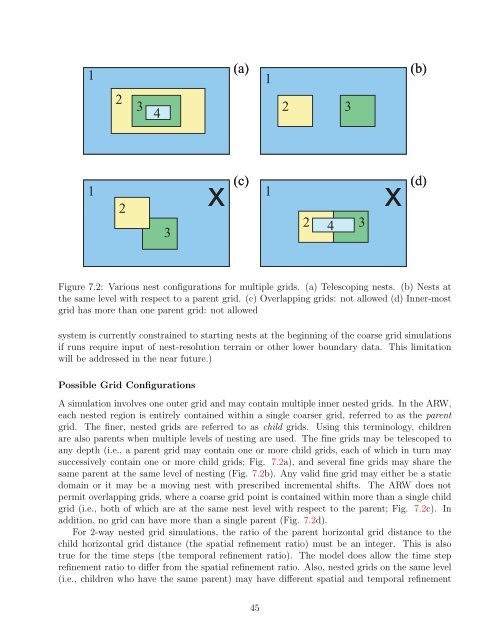Advanced Research WRF (ARW) Technical Note - MMM - University ...
Advanced Research WRF (ARW) Technical Note - MMM - University ...
Advanced Research WRF (ARW) Technical Note - MMM - University ...
You also want an ePaper? Increase the reach of your titles
YUMPU automatically turns print PDFs into web optimized ePapers that Google loves.
1<br />
1<br />
2<br />
2<br />
3<br />
4<br />
3<br />
(a)<br />
1<br />
2 3<br />
x<br />
(c)<br />
1 x<br />
2 4 3<br />
Figure 7.2: Various nest configurations for multiple grids. (a) Telescoping nests. (b) Nests at<br />
the same level with respect to a parent grid. (c) Overlapping grids: not allowed (d) Inner-most<br />
grid has more than one parent grid: not allowed<br />
system is currently constrained to starting nests at the beginning of the coarse grid simulations<br />
if runs require input of nest-resolution terrain or other lower boundary data. This limitation<br />
will be addressed in the near future.)<br />
Possible Grid Configurations<br />
A simulation involves one outer grid and may contain multiple inner nested grids. In the <strong>ARW</strong>,<br />
each nested region is entirely contained within a single coarser grid, referred to as the parent<br />
grid. The finer, nested grids are referred to as child grids. Using this terminology, children<br />
are also parents when multiple levels of nesting are used. The fine grids may be telescoped to<br />
any depth (i.e., a parent grid may contain one or more child grids, each of which in turn may<br />
successively contain one or more child grids; Fig. 7.2a), and several fine grids may share the<br />
same parent at the same level of nesting (Fig. 7.2b). Any valid fine grid may either be a static<br />
domain or it may be a moving nest with prescribed incremental shifts. The <strong>ARW</strong> does not<br />
permit overlapping grids, where a coarse grid point is contained within more than a single child<br />
grid (i.e., both of which are at the same nest level with respect to the parent; Fig. 7.2c). In<br />
addition, no grid can have more than a single parent (Fig. 7.2d).<br />
For 2-way nested grid simulations, the ratio of the parent horizontal grid distance to the<br />
child horizontal grid distance (the spatial refinement ratio) must be an integer. This is also<br />
true for the time steps (the temporal refinement ratio). The model does allow the time step<br />
refinement ratio to differ from the spatial refinement ratio. Also, nested grids on the same level<br />
(i.e., children who have the same parent) may have different spatial and temporal refinement<br />
45<br />
(b)<br />
(d)
















